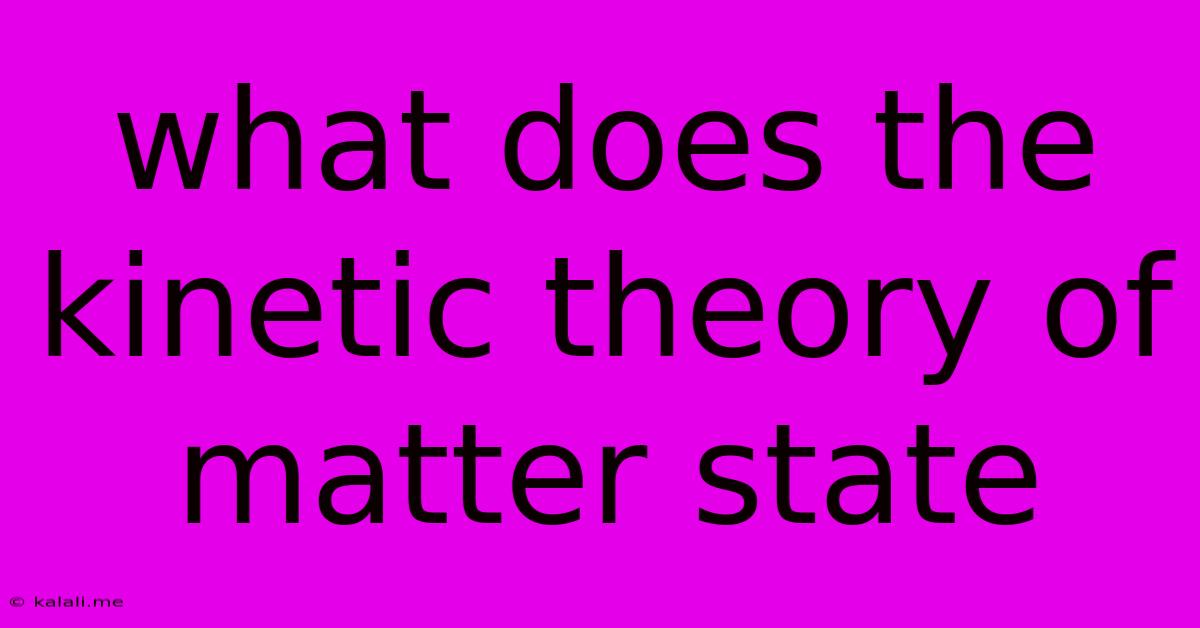What Does The Kinetic Theory Of Matter State
Kalali
May 09, 2025 · 3 min read

Table of Contents
What Does the Kinetic Theory of Matter State? A Deep Dive into Molecular Motion
The kinetic theory of matter is a fundamental concept in physics that explains the macroscopic properties of matter—like temperature, pressure, and volume—based on the microscopic behavior of its constituent particles (atoms and molecules). Understanding this theory provides a crucial link between the seemingly observable and the incredibly tiny, invisible world. This article will delve into the core tenets of the kinetic theory and explore its implications.
In essence, the kinetic theory of matter states that all matter is made up of tiny particles in constant, random motion. These particles are constantly colliding with each other and with the walls of their container. The energy of these particles, and thus their motion, is directly related to the temperature of the substance. Higher temperatures mean faster-moving particles, and vice versa.
Core Postulates of the Kinetic Theory of Matter
The kinetic theory rests on several key postulates:
-
Matter is composed of tiny particles: These particles can be atoms, molecules, or ions, depending on the substance. The size of these particles is negligible compared to the distances between them, especially in gases.
-
These particles are in constant, random motion: They are constantly moving and colliding with each other and the walls of their container. This motion is random, meaning there's no predictable pattern to their movement. The speed and nature of this motion vary depending on the state of matter (solid, liquid, or gas).
-
Collisions between particles are elastic: This means that during collisions, kinetic energy is conserved. No energy is lost during the collision; it's simply transferred between particles.
-
The average kinetic energy of particles is directly proportional to the absolute temperature: This is a crucial connection. The higher the temperature, the faster the particles move, and the higher their average kinetic energy. Absolute temperature (measured in Kelvin) is directly related to the average kinetic energy, not the speed of individual particles.
-
The forces of attraction or repulsion between particles are negligible, except during collisions: This postulate is particularly important for ideal gases. Real gases deviate from ideal behavior because intermolecular forces do play a role, especially at high pressures and low temperatures.
Implications of the Kinetic Theory
The kinetic theory elegantly explains various phenomena related to the states of matter:
-
Temperature and Heat Transfer: Heat transfer is simply the transfer of kinetic energy between particles. When a hot object touches a cold one, the faster-moving particles in the hot object collide with the slower-moving particles in the cold object, transferring energy and equalizing temperatures.
-
Pressure: The pressure exerted by a gas on its container is a result of the countless collisions of gas particles with the container walls. More collisions per unit time mean higher pressure.
-
Diffusion and Effusion: The random motion of particles explains how gases mix (diffusion) and how they escape through small openings (effusion). Lighter particles diffuse and effuse faster than heavier ones.
-
States of Matter: The kinetic theory explains the differences between solids, liquids, and gases in terms of the strength of intermolecular forces and the degree of particle motion. In solids, particles are tightly packed and vibrate in fixed positions; in liquids, they move more freely but are still relatively close together; and in gases, they are widely dispersed and move independently.
Beyond Ideal Gases: Real-World Applications
While the kinetic theory provides a simplified model, it's crucial to remember that real gases deviate from ideal behavior. The theory's postulates don't fully account for intermolecular forces, the finite size of particles, or quantum effects. However, the kinetic theory remains a powerful tool for understanding the behavior of matter and forms the basis for more complex models that incorporate these real-world considerations. It's a fundamental concept in numerous fields, including thermodynamics, chemistry, and materials science. Its applications extend far beyond simple gas laws, providing a microscopic perspective on macroscopic properties and enabling further exploration into the nature of matter itself.
Latest Posts
Latest Posts
-
How Many Sides Do Parallelograms Have
May 09, 2025
-
What Is 10 Percent Of 7
May 09, 2025
-
How Many Zeros Does Googolplex Have
May 09, 2025
-
What Is 12 As A Percent
May 09, 2025
-
What Is The Percentage Of 8 Out Of 15
May 09, 2025
Related Post
Thank you for visiting our website which covers about What Does The Kinetic Theory Of Matter State . We hope the information provided has been useful to you. Feel free to contact us if you have any questions or need further assistance. See you next time and don't miss to bookmark.